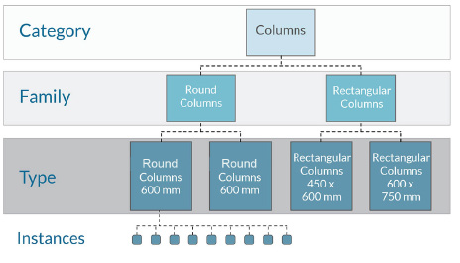The Building Blocks Of Revit: Understanding The Power Of Families
The Building Blocks of Revit: Understanding the Power of Families
Related Articles: The Building Blocks of Revit: Understanding the Power of Families
Introduction
With great pleasure, we will explore the intriguing topic related to The Building Blocks of Revit: Understanding the Power of Families. Let’s weave interesting information and offer fresh perspectives to the readers.
Table of Content
The Building Blocks of Revit: Understanding the Power of Families

Revit, a Building Information Modeling (BIM) software, revolutionized the way architects, engineers, and contractors design and construct buildings. At the core of this revolution lies a fundamental concept: families. These are not simply groups of objects; they are intelligent, customizable templates that represent the recurring elements found in buildings.
Understanding the Essence of Families
Imagine a project requiring numerous doors. Instead of individually modeling each door, Revit utilizes a door family. This family acts as a blueprint, defining the core characteristics of a door, such as its dimensions, material, swing direction, and hardware. By using this family, users can quickly place multiple doors throughout the project, ensuring consistency and saving time.
The Anatomy of a Family
Families in Revit are composed of two key components:
- Parameters: These are the defining attributes of a family. They control the size, shape, material, and other properties of the family instance. For example, a door family might have parameters for width, height, door type (single or double), and material.
- Geometry: This refers to the visual representation of the family, built using lines, arcs, and other geometric elements. The geometry is defined based on the parameters, ensuring that any changes to the parameters are reflected in the visual representation.
Types of Families
Revit offers various types of families, each catering to specific building elements:
- Basic Families: These are the simplest families, often representing single elements like walls, floors, or roofs. They are primarily used to define the structural elements of a building.
- Loadable Families: These families are more complex and can include features like doors, windows, furniture, and equipment. They are often created and shared by users or downloaded from online repositories.
- System Families: These families are pre-defined in Revit and represent complex systems like stairs, railings, and curtain walls. They offer advanced functionality and are often used for specific architectural features.
The Benefits of Using Families
Employing families in Revit offers numerous advantages:
- Consistency and Standardization: Families ensure that all instances of a particular element within a project adhere to a defined set of parameters, promoting consistency in design and construction.
- Enhanced Design Flexibility: Parameters within families allow users to easily modify the size, shape, and other properties of elements, facilitating quick design iterations and exploration of different options.
- Streamlined Workflow: Families significantly reduce the time required to model complex elements, enabling architects and engineers to focus on design and analysis rather than repetitive modeling tasks.
- Improved Collaboration: Families can be shared among project team members, ensuring everyone works with the same set of elements and promoting seamless collaboration.
- Data-Driven Design: Families are inherently linked to data, allowing users to extract information about the elements within a project, such as material quantities, costs, and energy performance.
FAQs: Unraveling the Mystery of Revit Families
Q: Can families be customized?
A: Absolutely. Families are highly customizable. Users can adjust parameters, add new features, or even create entirely new families based on existing ones.
Q: Where can I find families?
A: Revit comes with a library of pre-defined families. Additionally, numerous online repositories offer a vast collection of families created by users and manufacturers.
Q: How do I create a family?
A: Revit provides tools to create new families from scratch or by modifying existing ones. The process involves defining parameters, creating geometry, and establishing relationships between them.
Q: What are the limitations of families?
A: Families, while powerful, are not without limitations. Complex geometries or intricate details may require additional modeling techniques beyond the scope of standard families.
Tips for Effective Family Management
- Organize Families: Create a clear and logical naming convention for your families and organize them into folders for easy access.
- Use Parameters Wisely: Define parameters carefully, ensuring they accurately represent the key characteristics of the family.
- Leverage Shared Parameters: Utilize shared parameters to ensure consistency in data across different families and projects.
- Regularly Update Families: As projects evolve or design standards change, update families to reflect the latest requirements.
Conclusion: The Cornerstone of Revit
Revit families are the cornerstone of this powerful BIM software. They provide a structured and efficient approach to modeling building elements, promoting consistency, flexibility, and data-driven design. By mastering the creation and use of families, users can unlock the full potential of Revit, streamlining workflows, enhancing collaboration, and ultimately delivering better-designed and more sustainable buildings.


.png)




Closure
Thus, we hope this article has provided valuable insights into The Building Blocks of Revit: Understanding the Power of Families. We hope you find this article informative and beneficial. See you in our next article!
You may also like
Recent Posts
- Shaping The Homes Of Tomorrow: Home Decor Trends For 2025
- Navigating The Evolving Landscape Of Home Decor Trends: A Comprehensive Guide
- Weaving History And Home: A Guide To Unique Vintage Farmhouse Decor
- The Enduring Appeal Of Wooden Duck Home Decor: A Timeless Symbol Of Nature And Serenity
- Beyond The Ordinary: A Guide To Unique Home Decor Accessories
- Navigating The Fast Fashion Landscape: Exploring Alternatives To SHEIN
- A Global Network Of Home Improvement: The Reach Of The Home Depot
- Finding The Perfect Pieces: A Guide To Home Decor Shopping

Leave a Reply